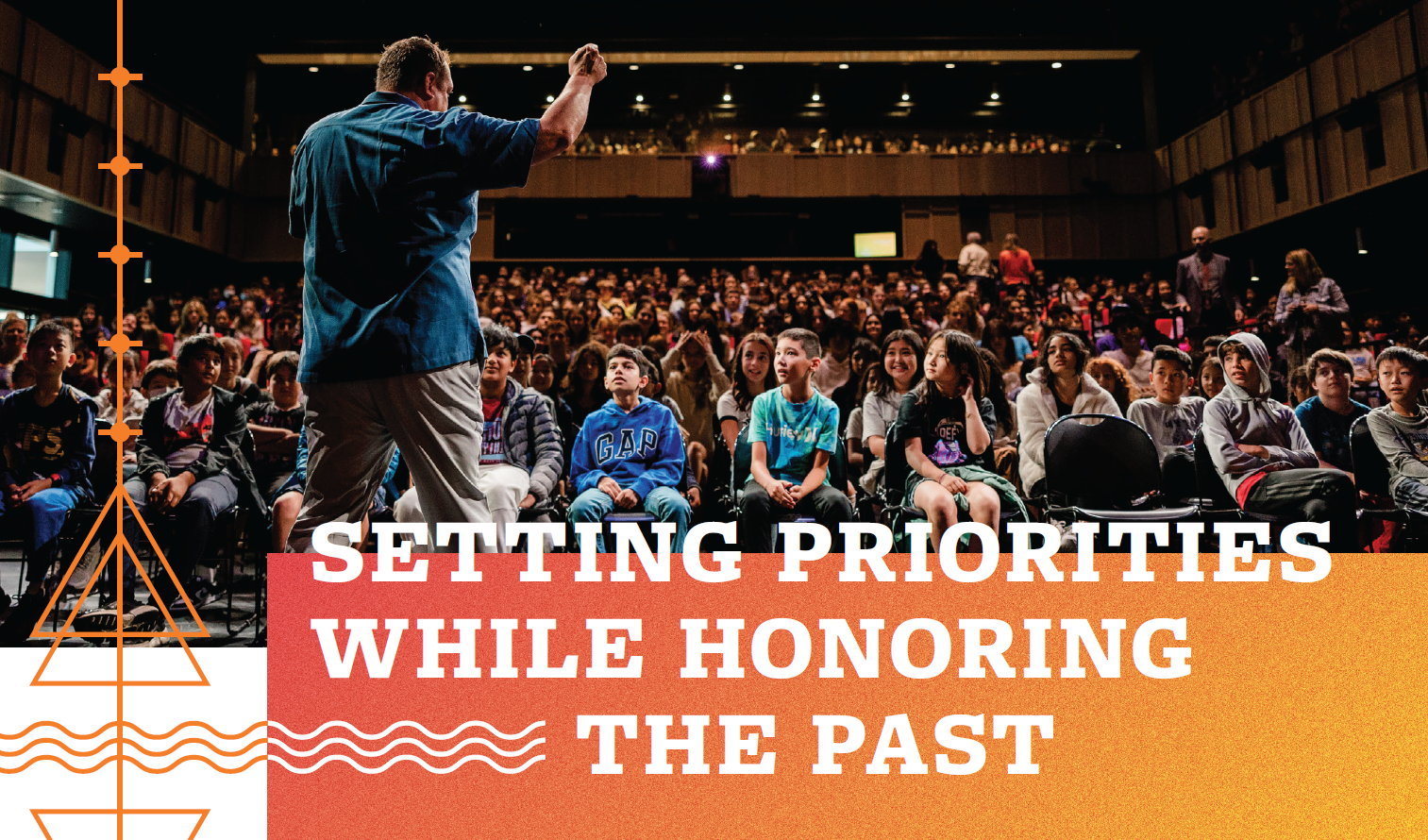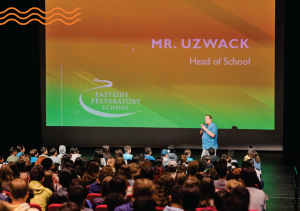
By Sam Uzwack, Head of School
WARNING: WHAT FOLLOWS IS A STREAM OF CONSCIOUSNESS. AT NO TIME WAS AI CONSULTED…WHICH MAY HAVE BEEN A GOOD IDEA.
My First Year as Head of School
If you are wondering what it is like to follow a successful, iconic founding head of school and how to establish your own priorities while honoring the footsteps you’re following, then this is the article for you! As I write these words (without the aid of the robots, mind you), I am six months and twenty-two days into my first headship. Let me take this opportunity to thank everyone—families, faculty, staff, and the Board of Trustees—for the generous support and positive feedback I have received during this time. It is wonderful to be so cared for by the community I care so much about.
Now back to my original, rambling query. Answering this plainly, it is an incredible gift and honor to be entrusted with the stewardship of
Eastside Prep following the retirement of Dr. Terry Macaluso. She casts a long shadow, so my challenge is to determine:
- How do we preserve and build upon our founding principles?
- What changes need to be made given the mature organizational phase we have entered?
- How do we create more transparency in our processes and decision-making?
EPS has deep roots that manifest on a daily basis. For example, our commitment to neurodiversity was a founding principle, and this commitment is evident in our robust Learning Support program and, more importantly, a culture that centers this support in the school, rather than it feeling like an add-on or a separate silo. In this way, we contribute to a culture of belonging. Over the past few years, similar efforts have been made to solidify a feeling of belonging for additional identities, particularly traditionally underrepresented groups such as LGBTQ+ and multigenerational African American students. When we seek to solve problems through the points of our Mission, we find success. By thinking critically about the issues, taking responsibility for them, providing compassionate and steadfast leadership, and perhaps discovering new innovations along the way, we are working to create a stronger sense of belonging for all. Efforts in this sphere have first been focused on the student experience, but we are also engaging families as a whole more and more so that everyone feels connected to the school.
So, with our founding principles alive and well as we move forward, we are at a critical moment in which we need to take stock of where the school is developmentally. What’s curious about this assessment is that the actual age of a school may not directly correlate to the current phase of development. We grew from a scrappy start-up to a mature, well-regarded local institution in a very short amount of time. This growth has meant an incredible array of experiences for students and families alike, but it also added increased complexity to our existing systems and structures. To put it simply, long gone are the days when we could grab a bus and take the whole school or grade on an impromptu adventure. To some, that feels like a loss. To others, an opportunity, for now activities on campus must be carefully considered and orchestrated. If I am to invoke our sixth grade Rube Goldberg project, if you turn a crank on one side of campus, there are going to be a number of ripples that can become felt on the other side. And those ripples can become collisions.
So how can we avoid the collisions? Consistency of practices. Repetition of efforts. With over half of our employees hired during the remote COVID years, and half of the employees off campus for two years, we have had to resuscitate a number of our practices. Emergency management. Registering for classes. Going through the lunch line. We are rebuilding this muscle memory, and by maintaining consistent, recognizable practices, we free up mind time for—you guessed it—more innovative forward looking practices.
 I sometimes joke about my first few initiatives being…boring. Build a website that houses all of our handbooks. Streamline those handbooks. Keep our regular schedule. One member of the leadership team even joked, “Wow, bold Sam!” But here is the thing. When we develop routine, we develop muscle memory. That leads to automaticity. This frees our minds from the day-to-day and allows our creative time to be spent pushing the envelope. Get ready for a silly example…why have the same header on every paper? So you’re not thinking about the rules of the headers. Why stick to a similar schedule year to year? So you are not relearning it.
I sometimes joke about my first few initiatives being…boring. Build a website that houses all of our handbooks. Streamline those handbooks. Keep our regular schedule. One member of the leadership team even joked, “Wow, bold Sam!” But here is the thing. When we develop routine, we develop muscle memory. That leads to automaticity. This frees our minds from the day-to-day and allows our creative time to be spent pushing the envelope. Get ready for a silly example…why have the same header on every paper? So you’re not thinking about the rules of the headers. Why stick to a similar schedule year to year? So you are not relearning it.
Freeing up mind time for more innovative pursuits and avoiding programmatic collisions. That’s what systematizing your practices can provide.
Once practices are systematized, the next step is to explain the “why” of those systems. All decisions in schools are based on a philosophical rationale. It is not always visible on the surface, but it’s there. And any critical thinker in the school is going to want to know “the why” behind all decisions. And “the who” that makes them. And how they were arrived at. In other words, context matters. Providing that context is an example of transparency. People have a hunger for this context, and I think, to the level it is appropriate, context should be shared. Now I am not talking about confidential issues surrounding disciplinary actions, salaries, and the like. (Although, interestingly, there are more and more calls for diminished confidentiality in these realms.)
One of the most striking generational distinctions between a Gen Xer like myself and Gen Z folks entering the workforce is exactly this. And as a leader, I have to do what is most effective for our school, which is not always what I might like to do personally. But that’s for another day.
You’re at the end of this article because you wondered what it is like to follow a successful, iconic founding head of school and how one establishes priorities while honoring the past. Well, there you have it. That’s a free-flowing, unfiltered, mildly allover- the-place account of what it is like to be the new head of a successful school that does NOT want to rest on its laurels. In fact, I think that’s the biggest mistake I could possibly make—play it safe and shy away from the bold and forward-looking decisionmaking that brought us to where we are today.

